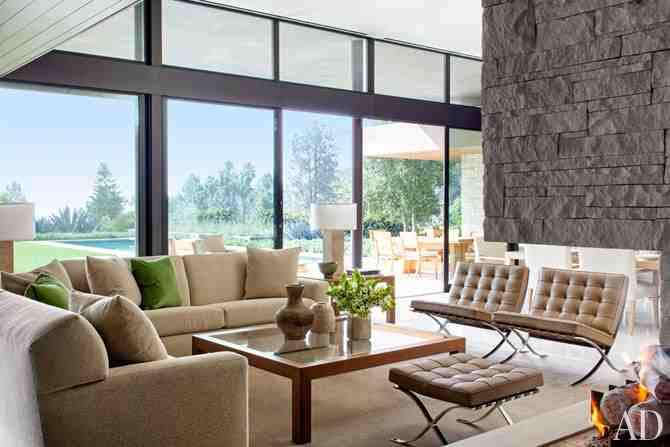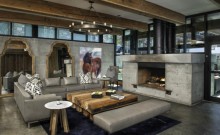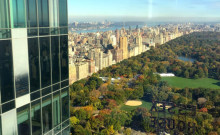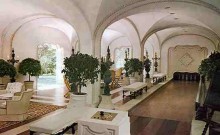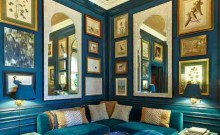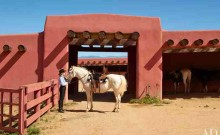A dashingly streamlined, decidedly intimate take on indoor-outdoor living, Skip Paul and Van Fletcher’s hillside residence is an elegant riff on midcentury style.
Skip Paul and Van Fletcher are remarkably well versed in California’s legacy of modern architecture and design. The couple is known in the Los Angeles and Bay Area design communities for restoring houses by such modernist architects as A. Quincy Jones and Gardner Dailey. They’ve nurtured midcentury gardens by Garrett Eckbo and Thomas Church back to life.
But when the time came to hire an architect to design a new house for a breathtaking site in the Trousdale Estates section of Beverly Hills, the two men decided to play down that track record and conduct a little experiment. Paul, a veteran entertainment-business dealmaker (a former top executive of the video-game company Atari, he is now a senior adviser at the investment firm Centerview Partners), dropped by the L.A. offices of Marmol Radziner without an appointment.
He and Fletcher were familiar with the work of partners Leo Marmol and Ron Radziner, not only their acclaimed restoration of Richard Neutra’s 1946 Kaufmann House in Palm Springs but also the numerous stylish, approachable neo-modern residences they’ve created from the ground up—many of them in California. Paul, however, wanted to enter the office as an anonymous potential client. “You get a sense of a firm by being there and sitting in the reception area,” he says. “And frankly, I fell in love with the manner of the place. As soon as I met Leo and Ron, I knew that they would grasp what we wanted to do.”
That meeting sparked an unusually harmonious collaboration. The house that Marmol Radziner devised for the couple, with interiors by Seattle-based decorator Don Boehm—a friend of Paul and Fletcher’s—is a seamless blend of livability and glamour that the homeowners jokingly call their “two-person resort.” It nods to California modernism without being hamstrung by it.
“There was definitely an assumption that Skip and Van might want a modern house, because they had that history,” Radziner says. But the home is more a riff on midcentury style than a copy, he notes, adding, “It’s about being a bit warmer, about relating back to the landscape.”
Indeed, the design is in every sense a response to its location in Trousdale, a swish residential community developed in the postwar years along a slope in the northeast corner of Beverly Hills. When Paul and Fletcher bought their property—primarily for the spectacular south-facing canyon, city, and ocean views—it included a 1960s Italianate dwelling, which they lived in for several years but ultimately decided to tear down. Building in Trousdale, however, meant dealing with certain constraints. The enclave imposes stringent regulations on regrading sites, and new residences must adhere to a 14-foot height limit. Some buyers chafe at those restrictions and head elsewhere. Not Paul and Fletcher.
“You learn a lot when you redo houses,” Paul says. “You learn about design and construction, but you also learn how you like to live. We didn’t want a place that was 8,000 square feet. We wanted a bigger garden and a smaller home.”
The plans Marmol Radziner came up with fit the couple’s expectations so naturally that they seem almost preordained. The four-bedroom dwelling is tucked into the hillside to maximize outdoor space. While the street-facing side is mostly solid (featuring stacked-stone and cement-plaster walls), the rear is lined with expanses of sliding glass that take advantage of the views and enable easy flow between the indoors and the terraces, pool, and lawn. Anchoring the high-ceilinged central portion of the house are the entertaining spaces—a great room, dining area, and kitchen—which are flanked on one side by the master suite and an intimate den, and on the other by a guest room and an office wing.
Throughout the residence, the emphasis is on earthy textures and finishes. Fireplaces in the great room and on the terraces are set into walls of thick ledger sandstone, ceilings are clad in cedar planks, and the color of the hand-troweled plaster walls was made to match that of the bark on the multitrunk oak trees Marmol Radziner brought in to give the garden some structure. In nearly every room, Paul says, “you have a feeling that you are surrounded by natural materials.”
Evoking Trousdale’s midcentury vision of domestic luxury, ivory terrazzo floors pave the entertaining areas and continue out onto the terraces. “There is definitely a glamour in this house, but it’s actually rather subtle,” says Boehm, whose furniture choices combine modern design icons (such as Mies van der Rohe’s Barcelona chairs) and custom-made tables and seating defined by clean lines and muted earth tones. Embellishing the home’s serene sophistication is a notable selection of postwar paintings by Sam Francis, Robert Motherwell, and Richard Pousette-Dart.
The garden, which features blue agave and Mexican feather grass, was carefully composed to reflect the character of the home. And it’s when you stand out by the pool and look back at the house that its architectural sensibility becomes clearest. The wide, flat roof of the building’s central section extends protectively over the two smaller wings, bringing the spaces for entertaining and the ones for quiet retreat into a close embrace.
Perhaps the strongest endorsement of the house is that it seems to have reformed Paul and Fletcher—serial renovators and nomadic lovers of California architecture—and convinced them that there is something to be said for staying put. “We’re going to live in this house the rest of our lives,” Paul declares. “During this entire project, we never once said the word resale.“

